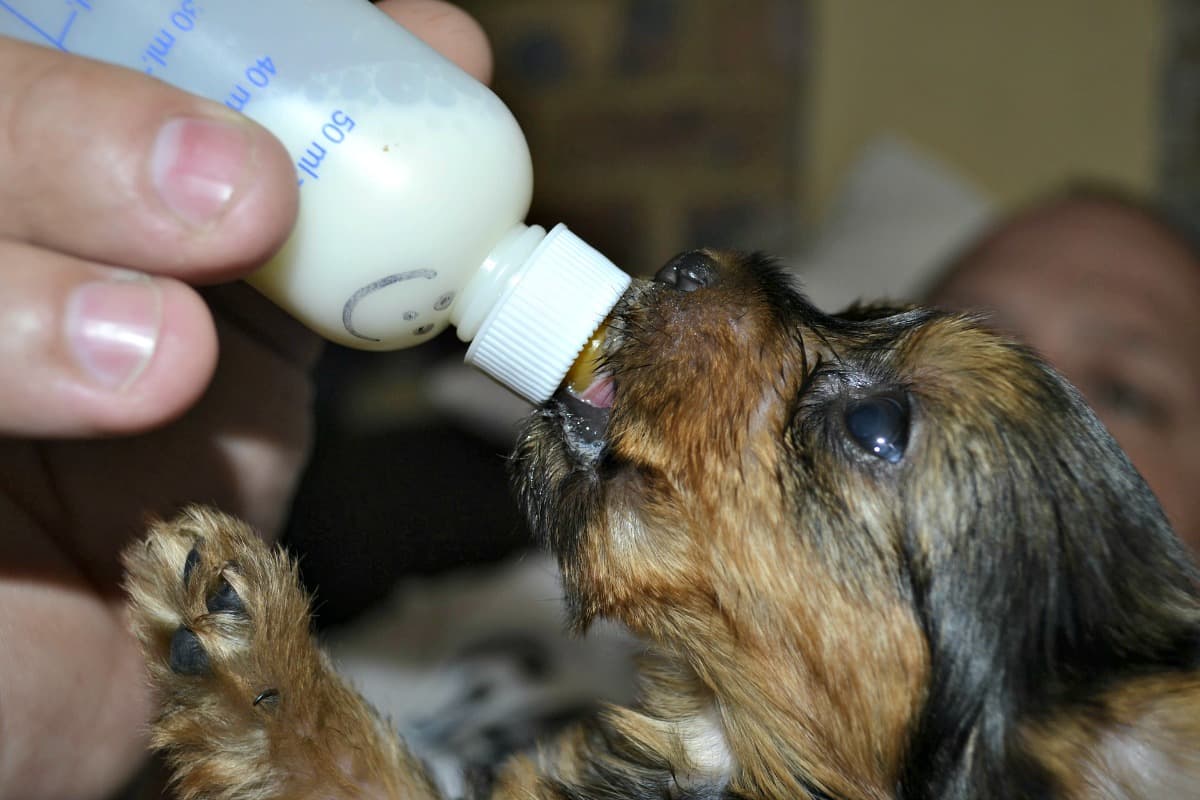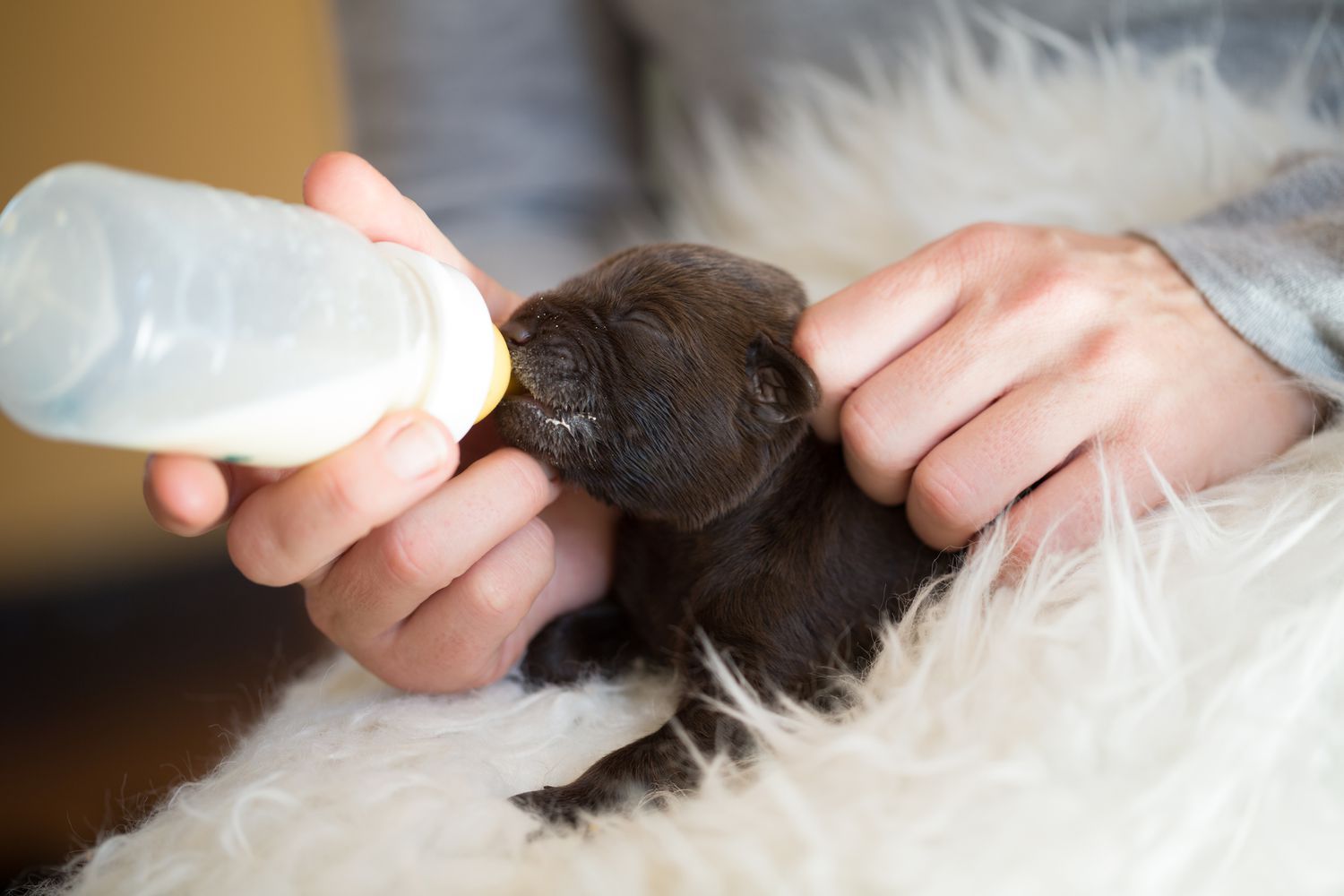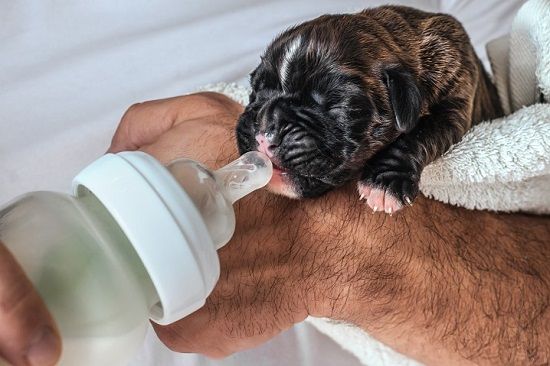Bottle feeding a puppy is a crucial skill for any pet owner, especially if you've found yourself caring for an orphaned or abandoned puppy. This comprehensive guide will walk you through the entire process, from preparation to troubleshooting common issues, ensuring that your puppy receives the care and nourishment it needs.

Preparing for Bottle Feeding
Before you embark on the journey of bottle feeding your puppy, it's imperative to make thorough preparations. The well-being of your furry companion depends on the proper equipment and hygiene standards you establish in this initial phase.
1. Gathering the Necessary Supplies
Your first step is to assemble the essential supplies:
Bottles and Nipples
Choose bottles specifically designed for puppies. These typically have smaller, more manageable sizes and suitable nipple shapes. Be sure to have a selection of nipple sizes to accommodate your puppy's growth.
Formula
Select a high-quality puppy milk replacer formula. Avoid using cow's milk, as it lacks the essential nutrients and can lead to digestive issues. The formula should meet the specific nutritional needs of puppies, supporting their rapid growth and development.

Thermometer and Heating Equipment
Maintaining the correct temperature of the formula is crucial. Use a thermometer to ensure the formula is warmed to around 98-100°F (37-38°C). Heating equipment, such as a bottle warmer or warm water bath, will help you achieve the right temperature consistently.
2. Sterilizing and Cleaning Equipment
Before every use, it's vital to sterilize and clean all feeding equipment. Proper sterilization prevents the growth of harmful bacteria and ensures your puppy's health:
- Boiling Method: Submerge bottles, nipples, and any other feeding equipment in a pot of boiling water for at least five minutes. Use tongs to handle them and place them on a clean, dry surface afterward.
- Use Dishwasher: Some bottles and nipples are dishwasher safe, but ensure they are thoroughly cleaned and dried before using them.
- Avoid Microwave: Avoid sterilizing in a microwave, as it can lead to uneven heating and damage to the equipment.
Maintaining cleanliness throughout the process is essential. Wash your hands thoroughly before handling the feeding equipment and formula, and use a clean, designated area for bottle preparation.
By diligently following these steps in preparing for bottle feeding, you'll provide your puppy with a safe and nurturing environment from the start, setting the stage for a healthy and happy journey together.
Mixing and Serving Formula
The correct preparation and serving of formula are pivotal in ensuring your puppy receives the essential nutrients and hydration it requires for healthy growth and development. This stage demands precision and careful attention to detail.
1. Measuring and Mixing Formula
The quality of your puppy's formula mixture directly impacts their overall health and well-being. Follow these steps to ensure proper mixing:
Choosing the Right Formula
Select a high-quality puppy milk replacer formula that is specifically designed for puppies. These formulas are nutritionally balanced to support the rapid growth and development of young dogs. Avoid using cow's milk, as it lacks essential nutrients and can lead to digestive issues.
Accurate Measurement
Use a measuring cup or scale to measure the recommended amount of formula powder as per the package instructions. Accuracy is crucial to provide your puppy with the right balance of nutrients. Do not guess or estimate.
Proper Mixing Technique
Follow the formula manufacturer's guidelines for mixing. Typically, this involves adding the measured powder to warm water and stirring until fully dissolved. Ensure there are no lumps or clumps in the mixture. The ideal temperature for the formula is around 98-100°F (37-38°C). Use a thermometer to verify the temperature.
2. Feeding Frequency and Quantity
The feeding frequency and quantity of formula depend on your puppy's age, size, and individual needs. It's vital to tailor the feeding schedule to your specific puppy's requirements.
Age-Based Feeding Schedules
- Newborns: Newborn puppies require feeding every 2-3 hours, even throughout the night. As they grow, the frequency decreases gradually.
- Three to Four Weeks: Around this age, you can extend the feeding intervals to every 4-6 hours. Puppies begin to develop more control over their digestive systems.
- Five to Eight Weeks: By this stage, most puppies can transition to solid food gradually. Consult your veterinarian for guidance on when and how to start this process.
Monitoring Your Puppy's Appetite
Observe your puppy's behavior and appetite during feeding. Some puppies may naturally have smaller or larger appetites than others. Ensure they are actively sucking and swallowing during feedings, which indicates proper latching and feeding.
Keeping a feeding schedule and monitoring your puppy's weight gain can help you adjust the quantity of formula to suit their needs as they grow.

By mastering the art of mixing and serving formula correctly, you provide your puppy with the foundation for optimal nutrition and health. Remember to maintain a consistent feeding routine and adapt it as your puppy matures to support their development effectively.
The Bottle Feeding Process
The bottle feeding process is a crucial aspect of caring for your puppy. Proper technique and a comfortable environment are essential to ensure that your puppy receives the nourishment it needs and that the feeding experience is positive and stress-free.
1. Holding and Positioning the Puppy
How you hold and position your puppy during bottle feeding plays a significant role in their comfort and ability to feed effectively.
Creating a Comfortable Feeding Environment
- Find a Quiet Space: Choose a quiet and calm area for feeding to minimize distractions and stress for the puppy.
- Gentle Handling: Handle your puppy with care and gentleness. Cradle them securely, ensuring their head is slightly elevated. This positioning mimics a natural nursing posture and helps prevent formula aspiration.
- Allow Natural Feeding Rhythms: Let your puppy set the pace. Allow them to initiate feeding by showing interest in the bottle. Avoid forcing the bottle into their mouth.
2. Feeding Techniques
Proper feeding techniques are essential to ensure your puppy gets the nourishment it needs while avoiding potential issues.
Ensuring a Proper Latch
- Nipple Placement: Place the nipple against your puppy's lips and let them take it into their mouth at their own pace. Ensure that the entire nipple is in their mouth to prevent air ingestion and promote efficient feeding.
- Avoid Forceful Feeding: Do not force the bottle into your puppy's mouth. Allow them to suckle naturally.
Avoiding Aspiration
- Upright Position: Keep your puppy in a slightly upright position during feeding. This helps gravity guide the formula downward, reducing the risk of aspiration.
- Bottle Tilt: Tilt the bottle downward, ensuring the nipple is always filled with formula. This prevents your puppy from swallowing air during feedings.
- Burp Breaks: Pause periodically during the feeding session to allow your puppy to burp and release any trapped air. Gently pat their back to facilitate burping.
3. Transitioning to Solid Food
As your puppy grows, you'll need to gradually transition them to solid puppy food. This is a natural progression in their development.
Introduction to Puppy Food
Start the weaning process around 3-4 weeks of age by introducing moistened dog food. Offer small amounts of softened puppy kibble, and gradually reduce the formula feedings. Consult your veterinarian for guidance on the weaning process.
Monitoring the Transition Process
Pay close attention to your puppy's response to solid food. Some puppies may take to it quickly, while others may need more time. Ensure they are eating and maintaining a healthy weight throughout the transition.
By following these guidelines for the bottle feeding process, you can ensure that your puppy receives the nourishment they need while creating a positive and nurturing feeding experience. Remember that every puppy is unique, so be patient and attentive to their individual needs and preferences during this essential phase of their growth and development.
Caring for Your Bottle-Fed Puppy
Caring for a bottle-fed puppy goes beyond the act of feeding itself. It encompasses a range of responsibilities to ensure your puppy's overall health, comfort, and well-being. This stage involves post-feeding care, monitoring, and providing the nurturing environment necessary for your puppy to thrive.
1. Burping and After-Feeding Care
Proper after-feeding care is essential to prevent discomfort and digestive issues in your puppy.
Preventing Digestive Discomfort
- Burping Your Puppy: After each feeding session, take a few minutes to help your puppy burp. Gently pat their back to encourage the release of any trapped air. This simple step can minimize gas and discomfort.
- Avoid Vigorous Play: Refrain from engaging in vigorous play immediately after feeding, as it can lead to upset stomach and vomiting. Allow your puppy some quiet time to digest their meal.

Cleaning and Sterilizing
- Cleanliness is Key: Maintain a clean feeding area, ensuring that bottles, nipples, and any other feeding equipment are washed and sterilized before every use. Clean your hands thoroughly before handling any equipment.
2. Monitoring Weight and Health
Regularly monitoring your puppy's weight and overall health is vital to ensure they are thriving and receiving adequate nourishment.
Weight Gain
- Healthy Weight Gain: Keep track of your puppy's weight. A healthy, well-fed puppy should steadily gain weight. Consult with your veterinarian if you notice any unusual weight fluctuations or stagnation.
General Health
- Observation: Pay close attention to your puppy's behavior and appearance. Monitor for signs of illness or distress, such as lethargy, diarrhea, vomiting, or abnormal behavior. If you notice any concerning symptoms, consult your veterinarian promptly.
By diligently following these after-feeding care and monitoring procedures, you play a crucial role in maintaining your puppy's health and comfort. This attentive approach helps ensure that your bottle-fed puppy thrives and grows into a happy and healthy adult dog.
Remember that each puppy is unique, and their needs may vary. Being observant and responsive to your puppy's individual requirements is key to providing the best care possible. If you ever have concerns about your puppy's health or development, do not hesitate to seek guidance from a qualified veterinarian. Your commitment and care are essential in fostering a strong bond and nurturing a healthy, happy puppy.
Troubleshooting Bottle Feeding Challenges
Bottle feeding a puppy can present various challenges along the way. Recognizing and addressing these challenges promptly is crucial for ensuring your puppy's health and well-being. Here, we explore common bottle feeding issues and provide guidance on how to troubleshoot them effectively.
1. Common Bottle Feeding Problems
Refusing the Bottle
Challenge: Some puppies may initially resist bottle feeding or refuse to latch onto the nipple.
Solution:
- Nipple Selection: Experiment with different nipple sizes and shapes to find one that your puppy is comfortable with.
- Nipple Warmth: Ensure the nipple is warm to the touch, mimicking the warmth of their mother's body.
- Feeding Environment: Create a quiet, stress-free feeding environment to minimize distractions and separation anxiety.
- Persistence: Be patient and persistent. Sometimes, puppies need time to adjust to bottle feeding.
Overfeeding or Underfeeding
Challenge: Determining the right quantity of formula can be challenging, leading to overfeeding or underfeeding.

Solution:
- Follow Guidelines: Adhere to the recommended feeding guidelines provided on the formula packaging. These guidelines are typically based on your puppy's age and weight.
- Monitor Your Puppy: Pay attention to your puppy's cues. If they appear hungry after a feeding, you may need to increase the quantity slightly. Conversely, if they seem disinterested or are experiencing discomfort, consider reducing the amount.
- Consult Your Veterinarian: If you're uncertain about the appropriate feeding amount, consult your veterinarian for personalized guidance.
2. Seeking Veterinary Advice
Sometimes, bottle feeding challenges may persist or become more severe. In such cases, it's essential to seek professional veterinary advice promptly.
When to Consult a Veterinarian
Consider veterinary guidance if you encounter any of the following:
- Persistent Refusal: If your puppy consistently refuses the bottle or shows signs of distress during feedings.
- Weight Loss: If your puppy is not gaining weight or experiences unexplained weight loss.
- Vomiting or Diarrhea: Frequent vomiting or diarrhea can be signs of an underlying issue.
- Lethargy or Illness: If your puppy appears lethargic, sickly, or displays unusual behaviors.
Your veterinarian is your best resource for addressing bottle feeding challenges that may be indicative of underlying health issues. Prompt consultation can help ensure your puppy's health and well-being.
Remember, patience and persistence are key when troubleshooting bottle feeding problems. Every puppy is unique, and it may take time to find the right solutions that work for your furry companion. By addressing challenges promptly and seeking professional guidance when needed, you can provide the best care for your bottle-fed puppy and ensure a smooth transition to a healthy, happy adult dog.
Gradual Transition to Solid Food
Weaning the Puppy
As your puppy grows, you'll need to transition it to solid puppy food. Gradually introduce the new diet and monitor the transition process closely.
Conclusion
Bottle feeding your puppy is a rewarding experience that allows you to bond with your furry friend while ensuring their health and well-being. With the right equipment, techniques, and care, you can provide your puppy with the best start in life.
FAQs
- Q1: How do I know if my puppy is getting enough formula?
- Look for signs of contentment, steady weight gain, and regular bowel movements as indicators of sufficient nourishment.
- Q2: Can I use a human baby bottle for my puppy?
- It's best to use bottles specifically designed for puppies, as they have appropriate nipple sizes and shapes.
- Q3: What if my puppy refuses the bottle?
- Experiment with different nipples, temperatures, and feeding positions. If problems persist, consult your veterinarian.
- Q4: When should I start weaning my puppy onto solid food?
- Begin the weaning process around 3-4 weeks of age, gradually introducing moistened puppy food.
- Q5: How do I clean and sterilize feeding equipment effectively?
- Boil bottles, nipples, and equipment for at least five minutes before every use, and ensure they are completely dry before filling with formula.
In this comprehensive guide, we've covered everything you need to know about bottle-feeding a puppy. From preparing the necessary supplies to troubleshooting common issues, you're now well-equipped to provide the best care for your furry companion. Remember to monitor your puppy's progress, consult your veterinarian when needed, and cherish the precious moments of bonding during this essential journey of nurturing your puppy.




